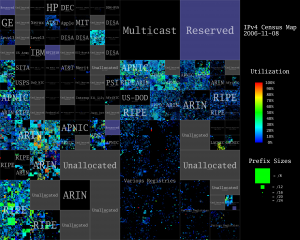Podcast: Play in new window | Download (Duration: 1:06:19 — 30.4MB)
Subscribe: Apple Podcasts | RSS
We returned to record our tenth episode on Sunday August 21, 2016.
Interesting News and Events
- Cisco, Fortinet confirm vulnerabilities from NSA Shadow Brokers hack
- How ICMPv6 Multicast Listener Reports almost spoiled Christmas – almost 2 years later I ran into this problem again on a Cisco Catalyst 4510R, packet trace of the problem provided the hint.
- Expired AP Certificates break Cisco Wireless LAN Controller
- FCC Regulatory Domain -B APs (additional 5Ghz channels and some DFS changes)
Roundtable Discussion – IPv6
IPv4
IPv4 provides an addressing capability of 232 or approximately 4.3 billion addresses
RFC 791 September 1981
Issues with IPv4 addressing:
- not enough available address space
- all blocks are already provisioned
- conflicting IPv4 addressing between networks requires NAT
Grey/Black market for IPv4 Address space;
Microsoft pays Nortel $7.5 million for IPv4 addresses – Bankrupt Nortel finds a buyer for 666K of its legacy IPv4 addresses, raising questions if the IPv4 black/grey market has arrived.
Cellular Mobile 3G/4G Networks – Carrier NAT
Local Internet Registry
- Asia-Pacific Network Information Centre (APNIC)
- Réseaux IP Européens Network Coordination Centre (RIPE_NCC)
- Latin America and Caribbean Network Information Centre (LACNIC)
- American Registry for Internet Numbers (ARIN)
- African Network Information Center (AFRINIC)
IP NG – early working-group proposals
The Internet Engineering Task Force adopted the IPng model on 25 July 1994, with the formation of several IPng working groups.[4] By 1996, a series of RFCs was released defining Internet Protocol version 6 (IPv6), starting with RFC 1883. (Version 5 was used by the experimental Internet Stream Protocol.)
IPv6 Addresses -128Bit 3.4×10^38 addresses
Just how many IPv6 addresses are there? Really?
Address Types
- Unicast
- Multicast
- Anycast
Dual-Stack IPv6 Use cases:
- Management networks
- home net / Mobile Laptop connectivity via IPv6 Tunnel
- mergers , change the subnet / prefix on the fly
IPv6: Privacy Extensions
- Stateless address autoconfiguration (SLAAC)
Neighbor Discovery
What is no longer available?
- NAT
- packet fragmentation by routers >> MTU path discovery has to be working for IPv6
- Broadcast
IPv6 Issues and Problems (IPv6 Multicast Listener Flooding)
http://packetpushers.net/good-nics-bad-things-blast-ipv6-multicast-listener-discovery-queries/
https://blog.bimajority.org/2014/09/05/the-network-nightmare-that-ate-my-week/ (Garrett Wollman)
How to check IPv6 connectivity
The Turtle is dancing – http://www.kame.net/
Who is already available in IPv6? More than you think, Google, Facebook and many other large web centric companies.
Tunnel Mechnaism:
Free 4to6 Tunnel broker:
https://tunnelbroker.net/ >> Hurricane Electric
IPv6 traffic is encapsulated into IPv4 using IPv6-in-IP, UDP (Teredo), or Intra-Site Automatic Tunnel Addressing Protocol (ISATAP)
IPv6 Cheat sheat – http://packetlife.net/media/library/8/IPv6.pdf
Naming IPv6 address parts – Proposed IETF RFC and a VOTE – chazwazza
Cheers!

